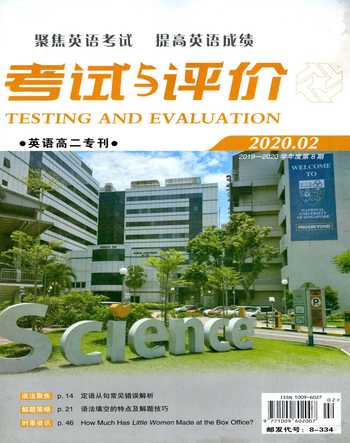语法填空的特点及解题技巧
2020-09-10耿让
耿让

首先看下表了解2019年全国高考新课标英语I卷、II卷、III卷语法填空考点:
考查内容
1. 纯空格题:通常考冠词、介词、代词和连词等四类词。
2. 用括号中所给词填空:通常考谓语动词的时态和语态、非谓语动词、形容词和副词的比较等级、词类转换等。
纯空格试题的解题技巧:
首先,分析句子结构,确定填哪类词。然后,再根据句子的意思,确定具体填什么词;或根据两句间的逻辑关系确定具体用哪个连词。确定填哪类词有以下技巧:
一、句子缺主语或宾语,一定是填代词、关系代词。
例证 1 (2019全国卷II) Now Irene Astbury works from 9am to 5pm daily at the pet shop in Macclesfield, _62_ she opened with her late husband Les. 分析句子结构可知,先行词为the pet shop,在非限制性定语从句中做opened一词的宾语,故用关系代词which。
例证 2 (2019全国卷III) They were well trained by their masters _64_ had great experience with caring for these animals. 它们被他们的主人训练得很好,它们的主人在照顾这些动物方面很有经验。先行词为masters (主人),且从句缺主语。故关系词填who。
二、句子不缺主语、表语、动词后不缺宾语的情况下,名词或代词前面,一定是填介词而且固定搭配较多。
例证1(2019全国卷I) Modem methods _63_ tracking polar bear populations have been employed only since the mid-1980s, 此处tracking polar bear populations... 做Modern methods的定语,用of 连接,“methods of doing sth.”,意为“……的方法”,构成固定结构。或者意为“对于跟踪北极熊的方法”用for。故填of/for。
例证2(2019全国卷III) We were first greeted with the barking by a pack _63_ dogs, seven to be exact. “a pack of”意为“一群”。故填of。
例证3 (2018全国卷III) I was searching _67_ these three western lowland gorillas I'd been observing. search for是固定搭配,表示“寻找”,表示“我”在寻找“我”研究的三只西部低地大猩猩。
三、 若两句(一个主谓关系算一个句子)之间没有连词,也没有分号或句号,一定是填并列连词或从属连词。
例证1(2019全国卷II) I work not because I have to, _67_ because I want to. 根据句意逻辑可知,此处为转折关系,句意:我工作不是因为我不得不做,而是因为我想做。此处用but与前文not 呼应,构成“不是……而是……”之意,故填but。
例证2 (2019全国卷I) ...Newfoundland. While they are rare north of 88°, there is evidence
_61_ they range all the way across the Arctic, and as far south as James Bay in Canada. 根據句子结构分析可知,主句为there be句型,且结构完整,空格后为同位语从句,解释说明中心词evidence的内容,故填连词that。
四、名词前面,若没有限定词(冠词、形容词性物主代词、不定代词),很可能是填限定词,有时也考固定搭配中的限定词。
例证1 (2019全国卷I) Of _62_ nineteen recognized polar bear subpopulations... 此处为特指,意为“在已知的19个北极熊亚种群中”,故填the。
例证2 (2019全国卷II) ...we thought it was _69_ joke. 根据句意“我们还以为这是一个玩笑”可知,此处joke为泛指,故填a。
五、若结构较完整,空格后的谓语动词是原形, 特别是与上下文时态不一致或主谓不一致时, 很可能是填情态动词或表示强调或倒装的助动词(do, does, did 等)。
例证 (2014新课标II卷) “_68_ anyone lose a suitcase at the last stop?” 这里助动词Did构成疑问和过去时态。
六、若句子缺状语,就要考虑when ,where, why。若前面有表示时间的名词,就要填关系副词when。
例证(2016新课标I卷) But my ... in the mid-1980s, _65_ I was the first Western TV reporter...。分析句子可知,些处用when引导定语从句,修饰the mid-1980s,因此要用关系副词when做状语。
七、由特殊的句式结构来判断空格应填的词。如:由 it is... that... 强调结构形式,判断填 it 还是 that。
给出了动词的试题的解题技巧:
首先,判断要填的动词是谓语动词还是非谓语动词。然后按以下两点进行思考:
一、若句中没有别的谓语动词,或者虽然已有谓语动词,但需填的动词与之是并列关系时, 所给动词就是谓语动词;若是谓语动词,就要考虑时态语态。
例证1(2019全国卷I) In recent years some Inuit people in Nunavut _65_ (report) increases in bear sightings around human settlements. 根据上下文语境,尤其是时间状语in recent years可知,主句用现在完成时态,故填have reported。
例证2 (2019全国卷II) Picking up her “Lifetime Achievement” award, proud Irene _64_ (declare) she had no plans... 根据上下文可知,该句主语为Irene,此处为谓语成分,根据后文had 以及said 可知用一般过去时态,故填declared。
例证3(2019全国卷III) Our hosts shared many of their experiences and _65_ (recommend) wonderful places to eat, hop, and visit. 句意:我们的主人跟我们分享了很多他们的经历并推荐了一些很好的吃饭、购物和参观的地方。“and”前后两个动作“shared”与“recommended”是并列关系,时态一致。故填recommeded。
二、若句中已有谓语动词,又不是并列谓语时,所给动词就是非谓语动词。若是非谓语动词 就要确定用-ing 形式、-ed 形式,还是用不定式形式。
例证1 (2019新课标I卷) Scientists have responded by _67_ (note) that hungry bears may be congregating... 根据其前介词by可知,此处用动名词主动形式,故填noting。
例证2 (2019新课标II卷) ... she had no plans _62_ (retire) from her 36-year-old business. 此处用to do sth. 做后置定语,用来修饰前面的名词plan,表示“……的计划”,故填to retire。
例证3(2019新课标III卷) ... hard that we couldn't help wondering how long it would take _62_ (get) there. It was in the middle of Pearl City. 句中的would提示我们作者还没有到达那座房子,wondering后的句子不缺谓语,此处应填非谓语动词,故填to get。
词类转换题的解题技巧:
根据该词在句子中所做的成分确定用哪种形式。
一、修饰名词用形容词词性物主代词。
例证 (2016新课标III卷) On my recent visit, I help a lively three-month-old twin that had been rejected by _68_ (it) mother. 本题考查形容词性物主代词,用its。
二、做主语、或在及物动词或介词后做宾语,用名词形式。
例证1 (2018 新课标II卷) This switch has decreased _66_ (pollute) in the country's major lakes and reservoirs and made drinking water safer for people. 句意:这一转变减少了中国较大的湖泊和水库的污染,使人們的饮用水更加安全。has decreased后跟名词做宾语,故填pollution。
例证2 (2016新课标II卷) Then, ... you'll feel a real sense of _42_ (achieve). achievement做介词宾语。
三、在形容词性物主代词后,或者在“冠词(+形容词)”后,用名词形式。
例证1 (2019新课标I卷) ... leading to a _66_ (believe) that populations are increasing.根据其前不定冠词和其后的同位语从句可知,空格处为名词形式,故填belief。
例证2(2019新课标III卷) ... they invited us to local events and let us know of an interesting _66_ (compete) to watch ...,由空格前的不定冠词an与空格后的不定式to watch可以确定空格处应该填名词形式。故填competition。
四、修饰动词、形容词、副词,或整个句子,做状语,用副词形式。
例证1 (2019新课标I卷) It is difficult to figure out a global population of polar bears as much of the range has been _62_ (poor) studied... 根据句意和结构分析可知,此处用副词poorly修饰谓语动词has been studied,意为“研究很少”。故填poorly。
例证2(2019新课标II卷) Her years of hard work have _63_ (final) been acknowledged after a customer nominated(提名) her to be Cheshire's Woman Of The Year. 根据空格所处位置可知,此处应用副词形式做状语,修饰谓语动词have been acknowledged,意为“最终得到认可”。故填finally。
例证3(2019新课标III卷) On our way to the house, it was raining _61_ hard that we couldn't help wondering... 句意:在我们去那座房子的路上,雨下得如此大以至于我们不能不
想……。“so... that...” 意为“如此……以至于……”,引导结果状语从句。故填so。
五、所给词为名词根据需要转化为复数形式。
例证 (2018新课标I卷) ... a day of running reduced the risk of heart disease and early deaths from all _67_ (cause). 考查名词复数。句意:一项研究表明,仅仅每天5到10分钟的跑步,就能减少各种原因的心脏病和早亡。空格处做from的宾语,由前面的all可知,要用名词复数形式。故填causes。
六、做表语、定语或补语,通常用形容词形式。
例证1 (2019新课标II卷) We are so proud of her. It's _70_ (wonder). 根据句子结构可知,在系动词is之后用形容词形式做表语。故填wonderful。
例证2(2019新课标III卷) They also shared with us many _67_ (tradition) stories about Hawaii... 空格修饰名词stories,应用形容词形式,tradition的形容词为traditional。故填traditional。
七、括号中所给动词也不一定是考动词的时态语态或非谓语动词,而是考词类转换;若是 形容词或副词,有可能是考查其比较级或最高级。
例证1(2019新课标I卷) ... around human settlements, leading to the illusion(错觉) that populations are _68_ (high) than they actually are. 根據其后than they actually are可知,此处为形容词的比较级。故填higher。
例证2 (2018新课标III卷) He screams the _63_ (loud) of all. The noise shakes the trees as the male beats his chest and charges toward me. 根据后面的of all可知,他声音最大,所以用最高级loudest。
